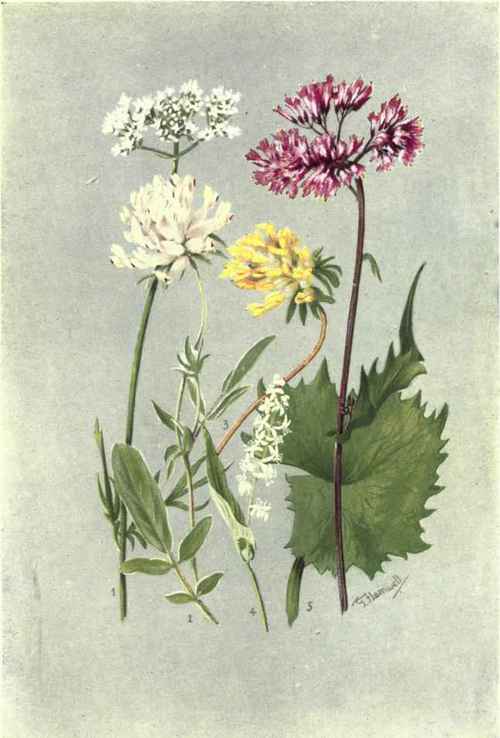Valerianaceae
Description
This section is from the book "Sub-Alpine Plants Or Flowers Of The Swiss Woods And Meadows", by H. Stuart Thompson. Also available from Amazon: Sub-Alpine Plants: Or, Flowers of the Swiss Woods and Meadows.
Valerianaceae
Herbs with annual or perennial stock, opposite leaves, and no stipules. Flowers in terminal corymbs or panicles, usually small and numerous. Calyx adherent to the ovary, sometimes toothed, but unrolling later into a feathery pappus. Corolla funnel-shaped, usually gibbous or spurred at the base. Lobes 3-5, unequal. Stamens 1-5. Ovary 3-celled, 2 of the cells being empty. Fruit small, indehiscent, 1-celled.
A family widely diffused over the greater part of the globe.
Valeriana L
Stem-leaves opposite or whorled, entire or pinnatifid. Flowers in corymbose panicled cymes, unisexual or bisexual. Calyx-limb annular, developing a feathery pappus. Corolla usually 5-lobed, irregular, usually gibbous at the base. Stamens 3.
A large genus, with the geographical range of the family, but most abundant in mountain regions.
Valeriana Tripteris L. (Plate XVII)
Rootstock with creeping runners. Stem erect, about a foot high, simple, furrowed, glabrous like the whole plant, or less often downy, with 3 or more pairs of leaves. Leaves of barren lateral tufts and lowest stem-leaves stalked, undivided, ovate or ovate-lanceolate, acute or obtuse, wavy or irregularly dentate, usually cordate at the base; upper stem-leaves with shorter stalks or sessile, 3-partite, divisions lanceolate, acute, irregularly toothed, the central one larger. Flowers small, reddish, sweet-scented, arranged in a terminal umbellate cyme.

1. VALERIANA TRIPTERIS.
2. ANTHYLLIS VULNERARIA VAR. ALPESTRIS.
3. ANTHYLLIS VULNERARIA.
4. MAIANTHEMUM BIFOLIU.M.
5. ADENOSTVLES ALBIFRONS.
4/7 NATURAL SIZE.
Rocky places and pastures up to 6000 feet. May, June.
Distribution
Carpathians; Eastern, Central, and Western Alps; Jura, Vosges, Black Forest, Cevennes, Pyrenees, Corsica.
Valeriana Montana L
Stem erect, 1-1 1/2 feet high, glabrous like the entire plant, less often downy. Leaves in 3 or more pairs, all undivided, ovate or ovate-lanceolate, acute or obtuse, entire or unequally toothed; those of the barren shoots and the lower stem-leaves stalked, often cordate at the base; upper stem-leaves more shortly stalked or sessile, narrower, the uppermost lanceolate. Flowers usually pink, in a terminal corymbose cyme. The root has a strong odour. Rocky, damp Alpine and sub-alpine places, descending to a low elevation; 3000-6500 feet; common. June to August.
Distribution
Carpathians; Eastern, Central, and Western Alps, Jura, Corbieres, Pyrenees.
Continue to:


